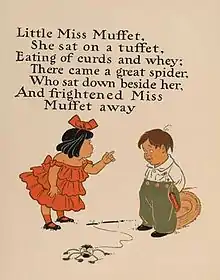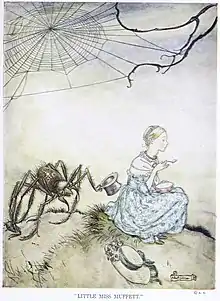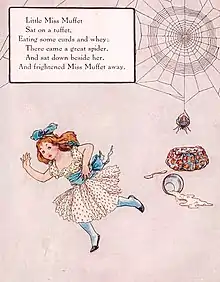Little Miss Muffet
"Little Miss Muffet" is an English nursery rhyme of uncertain origin, first recorded in 1805. It has a Roud Folk Song Index number of 20605.
 William Wallace Denslow's illustrations for one version of the rhyme, from a 1901 edition of Mother Goose | |
| Publication date | 1805 |
|---|---|
Wording
The rhyme first appeared in print in Songs for the Nursery (1805),[1] and there have been many variants since. The Oxford Dictionary of Nursery Rhymes gives the following:
- Little Miss Muffet
- Sat on a tuffet,
- Eating her curds and whey;
- There came a big spider,
- Who sat down beside her
- And frightened Miss Muffet away.[1]
Older versions sometimes use "of" rather than "her" in line 3, and refer to a "little spider" as in this example dating between 1837 and 1845:
- Little Miss Muffet
- She sat on a tuffet,
- Eating of curds and whey;
- There came a little spider,
- Who sat down beside her,
- And frighten'd Miss Muffet away.[2]
There are several early-published versions with significant variations including "Little Mary Ester sat upon a tester" (1812) and "Little Miss Mopsey, Sat in the shopsey" (1842).[1] Other collected variants have included "Little Miss Muffet, sat on a toffet" (1830s?) and "Little Miss Muffet, sat on a buffet" (1840s?).[3] In a later United States example, "whey" was replaced with "pie".[4]
"Tuffet"
Although the word "tuffet" is now sometimes used to mean a type of low seat,[5] the word in the rhyme probably refers to a grassy hillock, small knoll or mound (a variant spelling of an obsolete and rare meaning of "tuft").[6] The Oxford English Dictionary calls the "hassock or footstool" meaning "doubtful", and "perhaps due to misunderstanding of the nursery rhyme".[6]
Origins
The origins of the rhyme are unclear. Although no record has been found before 1805, Iona and Peter Opie argue that it is likely to be considerably older given its similarity to other rhymes such as "Little Polly Flinders", "Little Poll Parrot", "Little Tommy Tacket", "Little General Monk" and "Little Jack Horner" (the last known to have been current at least as early as 1720). It is possible that all of these rhymes, and others, are parodies of whichever unknown rhyme came first.[1]
It is sometimes claimed – without evidence – that the original Miss Muffet was Patience, daughter of Dr Thomas Muffet (d.1604), an English physician and entomologist,[7] but the Opies are sceptical given the two-hundred year gap between his death and the rhyme's appearance.[1] It has also been claimed to refer to Mary, Queen of Scots (1543–87), frightened by the religious reformer John Knox (1510–72).[8]
Cultural depictions
Several novels and films, including the Alex Cross novel Along Came a Spider (1993) and its eponymous 2001 film adaptation, take their titles from the poem's crucial line.
- Illustrations




References
- Opie, I. & Opie, P. (1997) [1951]. The Oxford Dictionary of Nursery Rhymes (2nd ed.). Oxford: Oxford University Press. pp. 323–4.CS1 maint: uses authors parameter (link)
- Songs for the nursery. London: Darton and Clark. 1837–1845. pp. 45.
- "Vaughan Williams Memorial Library". Vaughan Williams Memorial Library. Retrieved 11 February 2020.
- Sorby, A. (2005). Schoolroom Poets: Childhood and the Place of American Poetry, 1865–1917. UPNE. p. 80.
- Collins English Dictionary (Third ed.). Collins. 1998. ISBN 978-0-00-732119-3.
- "OED Online". Retrieved 11 February 2020. See entries for "Tuffet 2." and "Tuft 3b."
- For example: Harrowven, Jean (1977). Origins of Rhymes, Songs and Sayings. London: Kaye & Ward. pp. 173–174. ISBN 0-7182-1123-5.
- "Was Little Miss Muffet a local girl?". Brookmans Park Newsletter. Retrieved 4 February 2009.
External links
![]() Media related to Little Miss Muffet at Wikimedia Commons
Media related to Little Miss Muffet at Wikimedia Commons